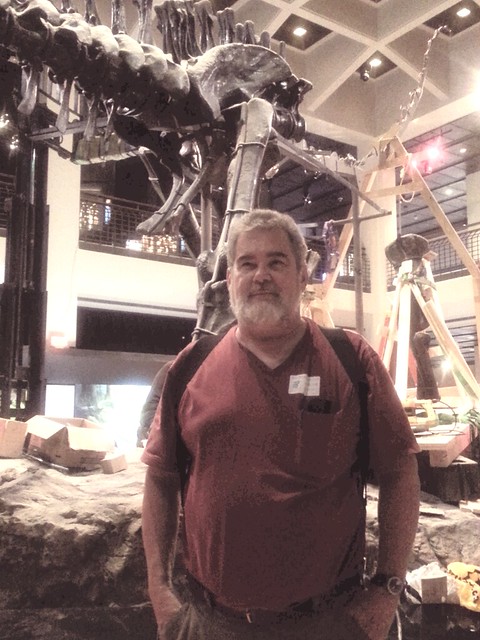There’s no sweeter story than that of a boy and his … dinosaur?
In February of 1973, 24-year-old John Barber was just out of art school in Virginia, having barely missed the draft and with no idea what to do with himself. He was visiting an aunt and uncle in Houston when he paid a visit to the Houston Museum of Natural Science — and happened upon a scene that would change his life.
“There was a large wooden platform raked at an angle, and a lot of large bones laid out in some kind of order. I walked around it a couple of times and realized that they were apparently going to assemble a big dinosaur,” Barber says. “I thought, holy cow!”
Having earned a fine arts degree in sculpture — and worked his way through school as a welder — Barber asked to speak to then-curator Dwayne Hicks to see if he might make himself useful. They reviewed his skills and 20 minutes later, Barber, now 64, left with a job.
Barber estimates he was making about $525 a month in those days. “I arrived in Houston with a small valise, a box of Magic Markers and a cardboard tube of drawing paper.”
Forty years later, Barber is back at HMNS supervising Dipsy’s de-installation. He paused to chat with us about his own history with Houston’s best-loved dinosaur and how it feels to see her come down.

Barber poses with Dipsy during her de-installation
When Barber first began work on Dipsy’s armature, 18 months of bone preparation had already been completed. For non-sculptors, an “armature” refers to the steel support that, in this case, took the place of cartilage and muscles that would have supported Dipsy’s skeleton in life. The objective, Barber says, was to make the support as unobtrusive as possible so the public would view the maximum amount of dinosaur bone and minimum steel support. His mentor, Dr. Wann Langston, used to joke, “If you do your work right, no one will ever see it.”
By 1975, Dipsy was revealed to the general public.

“We worked on that mount for almost two years,” Barber says. “Some people got upset that it took so long, but Dr. Langston was old school. His main interest in the mount was the feet. The reason our Diplodocus is mounted moving up a slope has to do with how the feet and legs were able to support that 30-ton mass going up a grade.”

In life, Dipsy would have weighed the equivalent of two tractor trailers stacked on top of one another. Even her skeleton is heavy enough that it required 250-pound, 8-inch I-beams for support, laid across two pieces of railroad track that are concealed in her base.
Barber remained in the Museum exhibit business — and in Houston — for the next 25 years, only more recently deciding to devote his full attention back to (more traditional) sculpture. His sheet metal sculptures of Gulf Coast wildlife are shown at galleries throughout the region and online at johnbarber.com.
“As we approach the task of disassembling the Diplodocus some 40 years since I started working on it, I find myself contemplating the issue of time — how 40 years is the working life of a man, but for a fossil specimen is but a moment. I feel that I have an obligation to that specimen; it changed the course of my life in a profound manner, and brought me into a line of work that I found artistically fulfilling and intellectually satisfying. How much more can a man ask for in life?”
Have your own special memory of Dipsy? Post it here in the comments or share it with us on Facebook!







